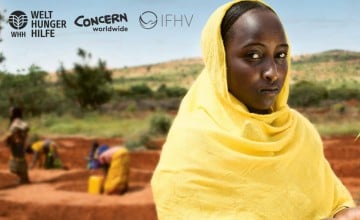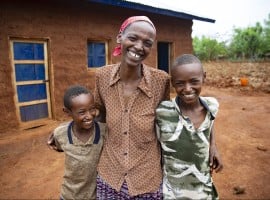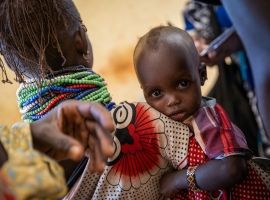
Read our 2024 annual report

Knowledge Hub
Report highlights need for urgency to tackle global hunger as progress stalls

- 42 countries have serious or alarming GHI hunger levels
- Conflict/armed violence fuelled 20 food crises affecting nearly 140 million people in the past year
- In parts of South and Southeast Asia, and Latin America, where there is stability and investment, levels of hunger continue to reduce
The possibility of achieving the UN Sustainable Development Goal of zero hunger by 2030 is slipping away. At the current rate of progress, it will take more than 100 years before low hunger levels globally will be reached, according to the Global Hunger Index (GHI) 2025, published today.
“At the current pace, at least 56 countries will not reach low hunger—let alone Zero Hunger—by 2030,” Concern Worldwide Director of Strategy, Advocacy and Learning Réiseal Ní Chéilleachair warned today at the launch of the GHI report. “If progress remains at the pace observed since 2016, low hunger at the global level may not be reached until 2137—more than a century away.”
The GHI is published by Irish humanitarian organisation Concern Worldwide, German aid agency Welthungerhilfe, and the Institute for International Law of Peace and Armed Conflict. The report notes that the lack of progress reported in 2025 reflects overlapping and accelerating global crises such as escalating conflicts, climate shocks, economic fragility, and political disengagement.
“But hunger is not inevitable. It is a result of the lack of sustained political will, policy failure, policy financing, and implementation,” Ms Ní Chéilleachair said. “Progress is evident in a number of countries, the report shows, especially on undernourishment. The international community needs to re-energise, re-commit and re-focus its efforts to tackle global hunger levels, prioritising communities and people who are most affected.”
Lack of progress
In 2025 – the 20th year of the GHI -- the global GHI score has improved only slightly compared to the 2016 score. The lack of progress toward achieving the Sustainable Development Goals is evidence of leaders’ policy ambivalence: stated ambitions are not being met with adequate resources or actions, the report notes. “Putting it in simple terms, talk is not being backed by action,” Ms Ní Chéilleachair said.
Instead of correcting course, many decision-makers are ignoring or underinvesting in commitments that they have already made. They are doubling down on de-stabilising policies. Vital monitoring and early-warning systems which are used to track hunger are being undermined by security risks, bureaucratic impediments, and funding cuts that hamper aid delivery and data collection.
The 2025 GHI shows that hunger is considered ‘alarming’* in seven countries: Burundi; Democratic Republic of the Congo; Haiti; Madagascar; Somalia; South Sudan; and Yemen.
In another 35 countries, hunger is designated as ‘serious’*. Furthermore, many countries are slipping backward: in 27 countries with low, moderate, serious, or alarming 2025 GHI scores, hunger has increased since 2016.
Data gaps
The report’s authors also express concern that there are data gaps which prevent the calculation of GHI scores in countries including Burundi, Democratic People’s Republic of Korea, the occupied Palestinian territories, Sudan and Yemen. These gaps obscure the true extent of hunger in these countries. Available indicators, however, point to deteriorating conditions and suggest that the reality is more alarming than the current figures reveal.
The GHI 2025 is published at a time when humanitarian funding is being cut and investment in military spending is increasing. Assistance is increasingly limited to only the most acute cases, leaving many without support.
Positive developments
As systems to measure and respond to hunger are dismantled or weakened, a dangerous loop is created where humanitarian needs are invisible and so attract no assistance, the report warns.
However, the GHI 2025 report also contains some positive developments, including global improvement in undernourishment levels in parts of South and Southeast Asia, and Latin America. It notes that sustained investments can drive meaningful progress in reducing hunger, pointing to examples from Angola, Bangladesh, Ethiopia, India, Nepal, and Sierra Leone.
For media queries and interview requests contact Eamon Timmins, Media Relations Manager, Concern Worldwide, at eamon.timmins@concern.net or 00 353 87 9880524
Notes to the editor
Notes to the Editor
To access the GHI 2025 report visit
*The GHI ranks countries based on four key indicators:
- Undernourishment – the share of the population with insufficient caloric intake;
- Child stunting – the share of children aged under-five who have low height for their age, reflecting chronic undernutrition;
- Child wasting – the share of children aged under-five who have low weight for their height, reflecting acute malnutrition;
- Child mortality – the share of children who die before their fifth birthday, partly reflecting the fatal mix of inadequate nutrition and unhealthy environments.
Countries are scored on a 100-point severity of hunger scale, where zero is the best possible score (no hunger) and 100 is the worst:
- Extremely alarming - 50 or greater;
- Alarming – 35 to 49.9;
- Serious – 20 – 34.9;
- Moderate – 10 -19.9;
- Low – 9.9 or lower.
Other ways to help
Corporate support
Is your company interested in working together for a common cause?
Fundraise for Concern
From mountain trekking to marathon running, cake sales to table quizzes, there are lots of ways you can support our work.
Buy a gift
With an extensive range of alternative gifts, we have something to suit everybody.
Leave a gift in your will
Leave the world a better place with a life-changing legacy.
Volunteer with Concern
The lots of ways to get involved with our work as a volunteer
School fundraising
Without the generous support from schools, we wouldn't be able to do the work that we do.

